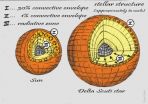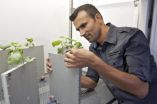Archivist in the sound library
New model for speech and sound recognition
2011-09-16
(Press-News.org) People are adept at recognizing sensations such as sounds or smells, even when many stimuli appear simultaneously. But how the association works between the current event and memory is still poorly understood. Scientists at the Bernstein Center and the Ludwig-Maximilians Universität (LMU) München have developed a mathematical model that accurately mimics this process with little computational effort and may explain experimental findings that have so far remained unclear. (PLoS ONE, September 14, 2011)
The so-called 'cocktail party-problem' has already kept scientists busy for decades. How is it possible for the brain to filter familiar voices out of background noise? It is a long-standing hypothesis that we create a kind of sound library in the auditory cortex of the brain during the course of our lives. Professor Christian Leibold and Dr. Gonzalo Otazu at LMU Munich who are also members of the Bernstein Center Munich now show in a new model how the brain can compare stored and perceived sounds in a particularly efficient manner. Figuratively speaking, current models operate on the following principle: An archivist (possibly the brain region thalamus) compares the incoming sound with the individual entries in the library, and receives the degree of matching for each entry. Usually, however, several entries fit similarly well, so the archivist does not know which result is actually the right one.
The new model is different: as previously the archivist compares the sound with the library entries, this time getting back only a few really relevant records and information about how much the archived and heard elements differ. Therefore, only in the case of unknown or little matching inputs are large amounts of data sent back. "Perhaps this is also one reason why we can ignore known sounds better than new ones," speculates Leibold, head of the study. During a test, the model was easily able to detect the sound of a violin and a grasshopper at the same time from 400 sounds with an overlapping frequency spectrum. Furthermore computational and memory requirements were significantly smaller than in comparable models. For the first time a library-based model allows a highly efficient real-time implementation, which is a prerequisite for an implementation in brain circuits.
Experiments long ago showed that a lot of information is sent from the cerebrum to the thalamus, so far without a universally accepted explanation. The new model predicts exactly this flow of information. "We quickly knew that our model works. But why and how, we had to find out laboriously," Leibold says. Abstract mathematical models of neurobiological processes have the advantage that all contributing factors are known. Thus, one can show whether the model works well in a broad, biologically relevant, application-spectrum, as in this case. The researchers now want to incorporate their findings into other models that are more biologically detail-oriented, and finally test it in psychoacoustic experiments. (Faber/Bernstein Coordination Site)
INFORMATION:
The Bernstein Center Munich is part of the Bernstein Network Computational Neuroscience (NNCN) in Germany. The NNCN was established by the German Federal Ministry of Education and Research with the aim of structurally interconnecting and developing German capacities in the new scientific discipline of computational neuroscience. The network is named after the German physiologist Julius Bernstein (1835-1917).
Information:
Bernstein Center Munich
www.bccn-muenchen.de
Bernstein Network Computational Neuroscience
www.nncn.de
LMU Munich
www.en.uni-muenchen.de
Publication:
A corticothalamic circuit model for sound identification in complex scenes
Otazu G, Leibold C
PlosONE, 12 September 2011
doi: 10.1371/journal.pone.0024270
Contact:
Prof. Christian Leibold
Department Biology II
LMU Munich
Bernstein Network Computational Neuroscience
Phone: +49 89 2180 74802
E-mail: leibold@bio.lmu.de
END
ELSE PRESS RELEASES FROM THIS DATE:
2011-09-16
PITTSBURGH—The signature spiral arms of the Milky Way galaxy were likely formed by an epic collision between the Milky Way and the Sagittarius Dwarf galaxy, according to a University of Pittsburgh researcher and his collaborators, published today in the prestigious British journal Nature.
Supercomputer simulations by Christopher W. Purcell, postdoctoral research associate in the Department of Physics and Astronomy in Pitt's School of Arts and Sciences, and colleagues report their findings in a paper titled "The Sagittarius Impact as an Architect of Spirality and Outer ...
2011-09-16
Dr. Shervin Louie, best Los Angeles dentist, has earned the status of Invisalign premier provider. This certificate is only awarded to those dental professionals who have achieved an exceptional level of Invisalign case experience.
Invisalign Preferred Providers have achieved a level of clinical training and experience in treating patients with the Invisalign system. Dentists must maintain regular treatment submission and complete ongoing training classes in order to earn the designation as a Preferred Provider of Invisalign.
"I am honored to be name an Invisalign ...
2011-09-16
NAIROBI, KENYA (12 SEPTEMBER 2011) – Restoring and preserving dryland forests and planting more trees to provide food, fodder and fertilizer on small farms are critical steps toward preventing the recurrence of the famine now threatening millions of people in the Horn of Africa, according to forestry experts from the CGIAR Consortium.
Across the Horn, drought-induced famine has claimed tens of thousands of lives and swelled refugee camps in Kenya, Ethiopia and elsewhere, with millions of starving people – many of them children. Bearing the brunt of the crisis is Somalia, ...
2011-09-16
This press release is available in German.
The stars are boiling! The reason is the energy generated in the center of the star that wants to escape. If this does not happen quickly enough, the star starts to 'boil' in the outer layers causing vibrations that result in light variations, like in the Sun. Such oscillations have now been discovered by Victoria Antoci and collaborators using the NASA spacecraft Kepler, but in a much hotter star. The scientists publish this in the most recent issue of Nature.
Besides the discovery of earth-like planets, astronomy is concerned ...
2011-09-16
Fluctuations of serotonin levels in the brain, which often occur when someone hasn't eaten or is stressed, affects brain regions that enable people to regulate anger, new research from the University of Cambridge has shown.
Although reduced serotonin levels have previously been implicated in aggression, this is the first study which has shown how this chemical helps regulate behaviour in the brain as well as why some individuals may be more prone to aggression. The research findings were published today, 15 September, in the journal Biological Psychiatry.
For the study, ...
2011-09-16
LOS ANGELES (Sept. 15, 2011) – Treatment with a telaprevir-based combination regimen for hepatitis C – heretofore a chronic, destructive and difficult to manage disease – effectively can be shortened to six months in about two-thirds of patients, finds a new study published Thursday in the New England Journal of Medicine.
Telaprevir, a drug approved for use against hepatitis C in May, inhibits replication of virus. This anti-viral drug and a similar medication called boceprevir have nearly doubled the number of patients with sustained response. Among patients treated ...
2011-09-16
Sabal Financial Group, L.P., formerly Milestone Asset Resolution Company, LLC, a diversified financial services management firm, announces the recent acquisition of a $158 million portfolio of performing and non-performing commercial real estate loans and commercial acquisition, development and construction loans and credit facilities. The acquisition represents the first sale transaction under the FDIC's pilot Small Investor Program ("SIP") and represents the commercial loan component of a larger $297 million loan sale mandated by the FDIC for the assets of failed ...
2011-09-16
Small group homes for people with dementia provide good quality care and a domestic environment where people can live as individuals and families can get involved. But tension can arise when it comes to deciding who takes responsibilities for certain practical and caring tasks.
Those are the key findings of a study of two group living care homes in the Netherlands, published in the September issue of the Journal of Clinical Nursing.
"It's estimated that 80 million people worldwide will suffer from dementia by 2040" says Ezra van Zadelhoff from Maastricht University. ...
2011-09-16
At least one of the "Big Three" credit ratings agencies exaggerated credit scores of private debt compared to public bonds during the last 30 years, according to a new study by researchers from Rice University, American University and Indiana University.
The recent downgrade of U.S. debt by Standard & Poor's makes the study timely, and the research adds to the current debate surrounding regulatory reliance on credit ratings and the current Securities and Exchange Commission proposal to standardize credit ratings across asset classes.
For the study, "Credit Ratings ...
2011-09-16
It has long been known that roots alter the soil in their immediate vicinity, where other microorganisms live and the chemical composition is altered compared to that further away from the roots. An international research team has now demonstrated in experiments at the Paul Scherrer Institute that the soil in the vicinity of roots also contains more water – contrary to the earlier belief that there must be less water in this region, as the plant takes up water from the soil. Apparently, however, plants create a small water reserve that helps to tide them over through short ...
LAST 30 PRESS RELEASES:
[Press-News.org] Archivist in the sound library
New model for speech and sound recognition


